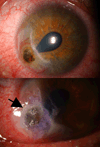Surgical management of corneal infections
- PMID: 27096375
- PMCID: PMC4966922
- DOI: 10.1097/ICU.0000000000000274
Surgical management of corneal infections
Abstract
Purpose of review: The purpose of this review is to discuss the options for, and recent developments in, the surgical treatment of corneal infections. Although the mainstay of treatment of corneal infections is topical antimicrobial agents, surgical intervention may be necessary in a number of cases. These include advanced disease at presentation, resistant infections, and progressive ulceration despite appropriate treatment. Prompt and appropriate treatment can make the difference between a good outcome and loss of vision or the eye.
Recent findings: There are a number of surgical therapies available for corneal infections. Preferred therapeutic modalities differ based on the size, causation, and location of the infection but consist of either replacement of the infected tissue or structural support of the tissue to allow healing. Although there are no completely novel therapies that have been developed recently, there have been incremental improvements in the existing treatment modalities making them more effective, easier, and safer.
Summary: Several options are available for surgically managing corneal infections. Ophthalmologists should select the optimal procedure based on the individual patient's situation.
Video abstract: http://links.lww.com/COOP/A20.
Conflict of interest statement
Figures




Similar articles
-
Surgical management of herpetic keratitis.Curr Opin Ophthalmol. 2018 Jul;29(4):347-354. doi: 10.1097/ICU.0000000000000484. Curr Opin Ophthalmol. 2018. PMID: 29708929 Review.
-
Surgical management of infectious and noninfectious keratitis.Int Ophthalmol Clin. 1998 Fall;38(4):197-217. doi: 10.1097/00004397-199803840-00018. Int Ophthalmol Clin. 1998. PMID: 10081735 Review. No abstract available.
-
Management of corneal perforation.Surv Ophthalmol. 2011 Nov-Dec;56(6):522-38. doi: 10.1016/j.survophthal.2011.06.003. Surv Ophthalmol. 2011. PMID: 22117886 Review.
-
Descemetocele.Surv Ophthalmol. 2021 Jan-Feb;66(1):2-19. doi: 10.1016/j.survophthal.2020.10.004. Epub 2020 Oct 13. Surv Ophthalmol. 2021. PMID: 33058926 Review.
-
Science and strategy for preventing and managing corneal ulceration.Ocul Surf. 2007 Jan;5(1):23-39. doi: 10.1016/s1542-0124(12)70050-2. Ocul Surf. 2007. PMID: 17252163 Review.
Cited by
-
Whole Corneal Descemetocele.Medicina (Kaunas). 2023 Oct 6;59(10):1780. doi: 10.3390/medicina59101780. Medicina (Kaunas). 2023. PMID: 37893498 Free PMC article.
-
Tectonic Deep Anterior Lamellar Keratoplasty to Treat Corneal Perforation and Descemetocele from Microbial Keratitis.Clin Ophthalmol. 2021 Aug 24;15:3549-3555. doi: 10.2147/OPTH.S324390. eCollection 2021. Clin Ophthalmol. 2021. PMID: 34465975 Free PMC article.
-
Procedures, Visits, and Procedure Costs in the Management of Microbial Keratitis.Cornea. 2021 Apr;40(4):472-476. doi: 10.1097/ICO.0000000000002534. Cornea. 2021. PMID: 33214415 Free PMC article.
-
Emerging antimicrobial resistance and need for antimicrobial stewardship for ocular infections in India: A narrative review.Indian J Ophthalmol. 2022 May;70(5):1513-1521. doi: 10.4103/ijo.IJO_2537_21. Indian J Ophthalmol. 2022. PMID: 35502016 Free PMC article. Review.
-
A Novel Vitamin E TPGS-Based Formulation Enhances Chlorhexidine Bioavailability in Corneal Layers.Pharmaceutics. 2020 Jul 8;12(7):642. doi: 10.3390/pharmaceutics12070642. Pharmaceutics. 2020. PMID: 32650410 Free PMC article.
References
-
- Lim M, Goldstein MH, Tuli S, Schultz GS. Growth factor, cytokine and protease interactions during corneal wound healing. OculSurf. 2003;1(2):53–65. - PubMed
-
- Hernandez-Camarena JC, Graue-Hernandez EO, Ortiz-Casas M, Ramirez-Miranda A, Navas A, Pedro-Aguilar L, et al. Trends in Microbiological and Antibiotic Sensitivity Patterns in Infectious Keratitis: 10-Year Experience in Mexico City. Cornea. 2015;34(7):778–785. - PubMed
-
- Duan R, de Vries RD, Osterhaus AD, Remeijer L, Verjans GM. Acyclovir-resistant corneal HSV-1 isolates from patients with herpetic keratitis. J Infect Dis. 2008;198(5):659–663. - PubMed
-
-
Fernandes M, Vira D, Dey M, Tanzin T, Kumar N, Sharma S. Comparison Between Polymicrobial and Fungal Keratitis: Clinical Features, Risk Factors, and Outcome. Am J Ophthalmol. 2015;160(5):873–881. e2. This article demonstrated that polymicrobial keratitis was not only more common but more challenging to treat and frequently required early penetrating keratoplasty. This is important to remind treating ophthalmologist to consider a co-infection with bacteria and fungus in patients who are responding poorly to medical management alone.
-
-
-
Pinheiro R, Panfil C, Schrage N, Dutescu RM. The Impact of Glaucoma Medications on Corneal Wound Healing. J Glaucoma. 2016;25(1):122–127. This article showed that Xalatan and BAC had deleterious effects on the corneal surface while Monoprost delayed corneal healing
-
Publication types
MeSH terms
Substances
Grants and funding
LinkOut - more resources
Full Text Sources
Other Literature Sources
Medical
Research Materials

